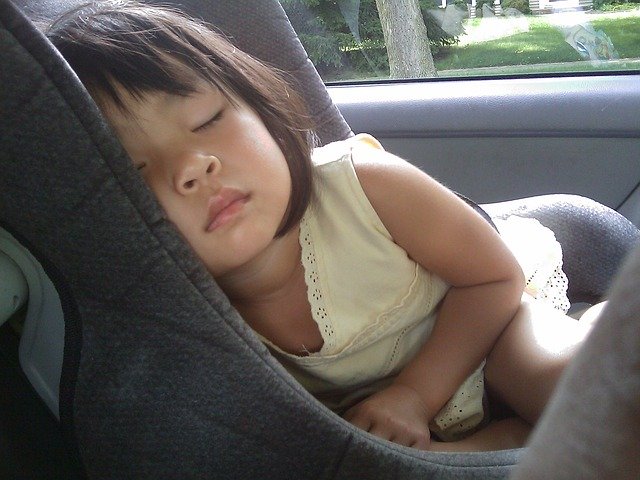
Whether you’re a parent or a nanny that drives the kids, the safety of the children in the car is paramount. These guidelines for child safety seats and boosters should be reviewed by parents and nannies alike.
Parents worry about their child’s safety, especially when the child is riding in a car. With the myriad of car seat models, vehicles and guidelines for proper installation, many parents wonder if they have installed their child’s car seat correctly. Unfortunately, these concerns are often warranted.
Sobering Statistics
According to the National Safe Kids Campaign, motor vehicle crashes are the leading cause of unintentional injury-related death among children 14 and under in the United States. Child safety seats and safety belts, when installed and used correctly, can prevent injuries and save lives. Young children properly restrained in child safety seats have a much lower risk of fatal injury than those who are unrestrained.
To be sure your child’s car seat is installed correctly, always refer to the car seat and vehicle manufacturer’s instructions, and review the following tips and guidelines.
General Tips for Child Safety Seats
Infants—Birth to 1 year and/or less than 20 pounds: Should have a rear-facing infant-only seat or convertible seat used as rear-facing. The seat should be secured to the vehicle by the seat belts or by the Lower Anchors and Tethers for Children (LATCH) system.
Infants—Less than 2 years and/or 20 to 35 pounds: Should have a convertible seat used rear-facing (select one recommended for heavier infants). The seat should be secured by the seat belts or by the LATCH system.
- Never use a rear-facing infant seat or a rear-facing convertible seat in a front seat where an air bag is present.
- Tightly install the child seat in the back seat, facing the rear of the vehicle.
- The child seat should recline at a 45-degree angle.
- Harness straps should be at or below shoulder level (usually the lower set of slots for convertible child safety seats).
- Harness straps should fit the child snugly and the harness clip should be at armpit level.
Toddlers & Preschoolers—2 to 4 years; at least 20 pounds to approximately 40 pounds: Should have a convertible seat used forward facing, or a forward-facing only seat, or high back booster or harness. Seat should be secured by seat belts or the LATCH system.
- Tightly install the child seat in the back seat, facing the front of the vehicle.
- Harness straps should be at or above the child’s shoulders (usually the top set of slots for convertible child safety seats.)
- Harness straps should fit the child snugly and the harness clip should be at armpit level.
Young Children—from 4 up to 12 years, or until the child is at least 4’9” (57”) tall: Should have a belt-positioning booster (no back, base only) or high back belt-positioning booster.
- Never use with lap-only belts. Belt-positioning boosters are always used with lap and shoulder belts.
- Booster base used with adult lap and shoulder belt in the back seat.
- Belt should rest snugly across the child’s chest and rest on his or her shoulder. The shoulder belt should never be placed under the arm or behind the back.
- The lap belt should rest low, across the lap or upper thigh area. It should never rest across the stomach.
The One-minute Car Seat Safety Check
Using a child safety seat correctly is the key to keeping your child safe in case of an accident. If the seat is not installed properly, it may not protect your child in a crash. It only takes a few minutes to check the seat to be sure it is installed properly, so follow these easy steps to ensure your child’s safety:
1) Do you have and understand your child’s safety seat instructions?
- Always read the child seat use and installation instruction manual.
- Read the seat belt and child seat installation sections of your vehicle owner’s manual.
2) Does your child ride correctly in the seat?
Infants and toddlers from birth to age 2 who are less than 35 pounds should ride in the back seat in a rear-facing safety seat.
- Harness straps should be at or below the child’s shoulders, fitting snugly and lying in a relatively straight line without sagging.
- Harness chest clip should be placed at the infant’s armpit level to keep the harness straps positioned.
- Infants and toddlers weighing 20 to 35 pounds before age 2 should ride rear-facing in convertible child safety seats rated for heavier infants.
Children over 2 years and at least 35 pounds may ride in forward-facing child safety seats in the back seat. Children should ride in safety seats with full harnesses until they weigh approximately 40 pounds.
- Harness straps should be at or above the child’s shoulders, threaded through the top slots in most cases.
- Harness should be snug. Straps should lie in a relatively straight line without sagging.
- Harness chest clip should be at the child’s armpit level, which helps keep the harness straps positioned properly on the child’s shoulders.
All children who have outgrown child safety seats should be properly restrained in booster seats until they are at least 4’9” tall, or until they reach 12 years of age, whichever comes first.
- Belt-positioning boosters can only be used with both the lap and shoulder belts across the child. The shoulder belt should be snug against the child’s chest, resting across the collarbone. The lap belt should lay low across the child’s upper thigh area.
- Boosters should be used as “in between” safety devices for children over 40 pounds who have outgrown forward-facing child seats.
- Booster seats should be used until the child can sit with his or her back against the vehicle seat’s back cushion, knees bent over the seat cushion edge and feet on the floor.
For more information about child safety seat installation and child passenger safety from the National Highway Traffic Safety Administration (NHTSA), visit www.nhtsa.dot.gov.
© 2007-2009. 2012, 2014, 2017-2018 Zywave, Inc. All rights reserved.
